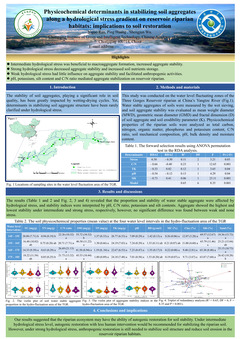Physicochemical determinants in stabilizing soil aggregates along a hydrological stress gradient on reservoir riparian habitats: implications to soil restoration
编号:2705
稿件编号:683 访问权限:仅限参会人
更新:2021-07-05 22:19:08
浏览:1205次
张贴报告
摘要
The stability of soil aggregates, playing a significant role in soil quality, has been greatly impacted by wetting-drying cycles. Yet, determinants in stabilizing soil aggregate structure have been rarely clarified under hydrological stress. Therefore, under the hydrological stress, this study evaluated the relative importance of soil physicochemical properties in stabilizing soil aggregates on water level fluctuating zones of the Three Gorges Reservoir riparian at China’s Yangtze River. Water stable aggregates of soils (large macroaggregates: > 2 mm, small macroaggregates: 0.25 ~ 2 mm, microaggregates: 0.053 ~ 0.25 mm, silt - and clay - sized aggregates: 0 ~ 0.053 mm) were measured by the wet sieving, and soil aggregate stability was evaluated as mean weight diameter (MWD), geometric mean diameter (GMD) and fractal dimension (D) of soil aggregate and soil erodibility parameter (K). Physicochemical properties of the riparian soils were analyzed as total carbon, nitrogen, organic matter, phosphorus and potassium content, C/N ratio, soil mechanical composition, pH, bulk density and moisture content. The results indicated that soil total carbon, nitrogen, organic matter, phosphorus and potassium were highly concentrated in the areas under strong hydrological stress; the pH was mainly alkalinity, pH value and bulk density both decreased along the incremental stress gradient. The findings revealed that the proportion and stability of water stable aggregate were affected by hydrological stress, and stability indices were interpreted by pH, C/N ratio, potassium and silt contents. Aggregate showed the highest and lowest stability under intermediate and strong stress, respectively, however, no significant difference was found between weak and none stress. Finally, our results suggested that the riparian ecosystem may have the ability of autogenic restoration for soil stability. Under intermediate hydrological stress level, autogenic restoration with less human intervention would be recommended for stabilizing the riparian soil. However, under strong hydrological stress, anthropogenic restoration is still needed to stabilize soil structure and reduce soil erosion in reservoir riparian habitats.
关键字
Aggregate stability;Hydrological stress;Mean weight diameter;Soil restoration
稿件作者
冉义国
中国科学院重庆绿色智能技术研究院
黄平
中国科学院重庆绿色智能技术研究院
吴胜军
中国科学院重庆绿色智能技术研究院


发表评论